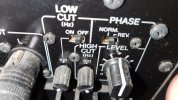Flex is a 2 channel input and 4/8 channel output device. That means you have left channel input and right channel input.i do not understand what is the difference between in and out. Excuse my ingnorance i have only made a manual room correction on one room and that was for roon which has an easy interface in this matter.
You can use left (or right) input signal and send it to any number of output channels, for example Left input to left sub, left midbass and left tweeter, which would use 3 channels of output to the left active speaker.
Or in a more usual case - to left and right normal passive speakers with 2 or 4 channels left for subwoofers.
So that means any EQ done on the Left Input channel will work for the left speaker(s) only. We call EQ on the input channel for Global EQ because it gives the same EQ for all drivers/speakers assigned to that input channel.
Hope this makes sense.


